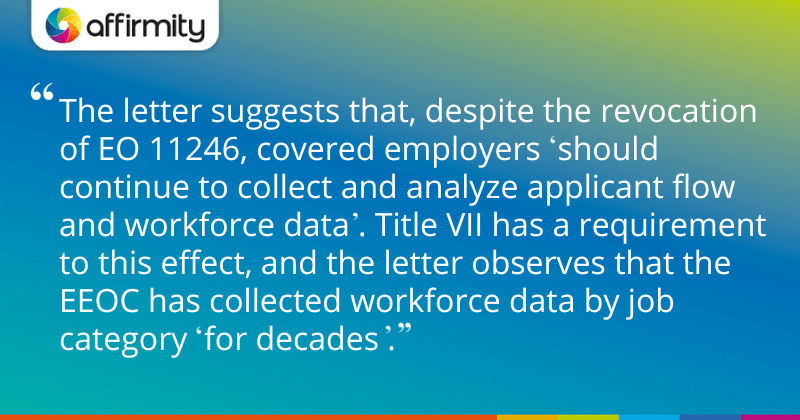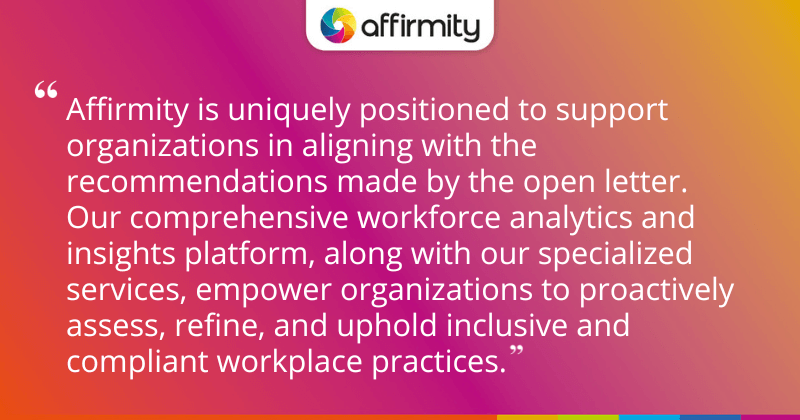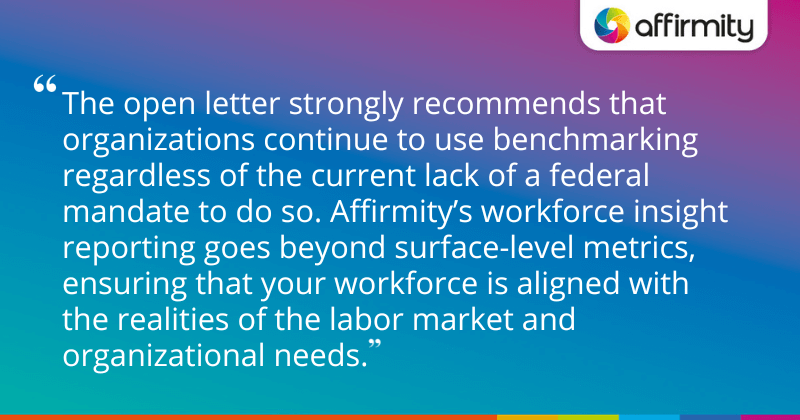Over three months have now passed since the revocation of Executive Order 11246 by the Trump administration in a new EO, which also targeted “illegal DEI”. The new order suggested that federal contractors could continue to comply with the prior regulatory scheme for a (now-expired) period of 90 days. So what should federal contractors do now? In this article, Kim Hendon, Affirmity’s Vice President of Sales, takes a look at how a recent open letter from a group of former Department of Labor officials provides a potential course of action for organizations that intend to continue to further their existing inclusion objectives.
What Is the Former U.S. DoL Officials’ Open Letter About?
As reported by Reuters, the open letter urges federal contractors to maintain their corporate diversity policies despite the prospect of legal threats by the Trump administration, on the basis that “President Trump and Director Eschbach have no authority to forbid lawful equal opportunity programs by federal contractors”. The 14-page open letter cites a range of case law in its argument and emphatically defends Executive Order 11246 and its implementing regulations as “promot[ing] merit in hiring, compensation, and promotion practices”.
The letter was signed by 10 former U.S. Department of Labor officials, including former OFCCP Directors Patricia A. Shiu and Jenny R. Yang (directors during the Obama and Biden administrations, respectively). Yang, in a post on LinkedIn, highlights the following key points, claiming:
- “The Administration’s actions contradict established law. Presidential executive orders cannot override Congressional civil rights mandates, and the targeting of federal contractors threaten our Constitutional protections. Indeed, there is no authority for OFCCP to investigate federal contractors’ affirmative action programs after the revocation of EO 11246.”
- “Compliance with EO 11246 did not involve race, gender, or other preferences or quotas. Rather, the implementing regulations promoted merit in hiring, compensation, and promotion practices and ensured qualified individuals were not excluded based on their background.”
- “Diversity, equity, inclusion, and accessibility programs remain lawful, help prevent discrimination, and leverage talent. Contractors can and should voluntarily continue proactive self-analysis, including data analysis, and other efforts to remove discriminatory barriers.”
RECENT NEWS | ‘Recent OFCCP Developments Under Its New Director, the Compliance Implications, and Your Next Steps’

Highlights From the Open Letter
In a section of the letter titled “Federal Contractors Should Continue to Use Lawful and Effective Tools to Ensure Equal Opportunity”, it is argued that “the effort to forbid federal contractors from taking proactive measures that had previously been used to comply with EO 11246’s implementing regulations is fundamentally at odds with Title VII and the Constitution”. It then calls these measures “powerful tools that help employers attract and retain qualified talent and foster innovation and business performance—as well as provide sound risk management.”
The letter then proceeds to make three design recommendations that promote effective and lawful practices:
1) Proactive Barrier Analysis Remains Fully Lawful and Essential to Prevent Discrimination
The letter defines “barrier analysis” as “a self-assessment approach used to identify and remove obstacles that prevent equal employment opportunity”, and cites examples such as:
- Examining a hiring process to understand high rejection rates for qualified candidates from certain backgrounds
- Analyzing high turnover rates for particular workers to determine potential driving factors.
- Conducting pay equity analyses to ensure that pay practices are fair and non-discriminatory.
The letter advises that employers who do not perform these barrier analyses “face an increased risk of liability” and may fail to identify and address the unlawful practices they’re engaging in.
2) Continuing to Collect and Analyze Workforce Data Remains Advisable
The OFCCP has historically required federal contractors to collect and analyze both applicant flow data and workforce demographic data. The letter suggests that, despite the revocation of EO 11246, covered employers “should continue to collect and analyze applicant flow and workforce data.” Title VII has a requirement to this effect, and the letter observes that the EEOC has collected workforce data by job category “for decades”.
3) Organizations Should Continue Tracking Progress Through Well-Crafted Benchmarks
OFCCP regulations encouraged employers to set benchmarks or aspirational goals while monitoring for discrimination across recruitment, hiring, promotion, and other practices. The open letter posits that even in the absence of a federal mandate to continue benchmarking, it remains a useful tool. It states: “An appropriate benchmark helps employers to assess their full utilization of the qualified labor pool in their geographic area.” Additionally, existing law already dictates that goals or benchmarks:
- Must not be mandatory or inflexible quotas requiring a certain number of people from specific demographic groups
- Should be based on an analysis of the qualified, available labor pool
- Should be supported by employers establishing safeguards to make sure hiring and promotion decisions focus on job-related skills and abilities so that decisions remain merit-based
GET OUR QUICK GUIDE TO BEST PRACTICES | ‘Your Post-EO 11246 Non-Discrimination Best Practice Checklist’

How Affirmity Can Help
Affirmity is uniquely positioned to support organizations in aligning with the recommendations made by the open letter, while remaining within the bounds of the new EOs the letter interprets. Our comprehensive workforce analytics and insights platform, along with our specialized services, empower organizations to proactively assess, refine, and uphold inclusive and compliant workplace practices. Here’s how:
1) Barrier and Talent Decision Analysis
To support the format of thorough barrier analysis consistent with that outlined in the open letter, Affirmity helps organizations:
- Conduct talent decision analyses to identify disparities in hiring, promotion, and termination decisions
- Run adverse impact analyses at each step of the hiring and talent management process to uncover and address hidden biases
- Evaluate outreach effectiveness and highlight opportunities to improve the diversity of candidate pipelines
This level of insight is essential for federal contractors aiming to demonstrate merit-based decisions and make good faith efforts that foster an inclusive workplace.
2) Comprehensive Pay Equity Analysis
Pay equity analyses are mentioned among the open letter’s examples of barrier analysis, and Affirmity’s pay equity software and services enable organizations to:
- Conduct organization-wide pay disparity assessments
- Drill down into specific business units or job categories to identify higher-risk areas
- Take action to correct disparities and reduce legal and reputational risk
Our pay equity tools help meet evolving expectations for fair compensation practices and transparency.
3) Proactive Workforce Analysis for Regulatory Compliance
Affirmity’s workforce compliance solutions help organizations comply with remaining Title VII and EEOC compliance requirements by:
- Analyzing and reviewing selection rates across demographic groups
- Developing and applying availability benchmarks to identify gaps in representation
- Preparing accurate data for state and federal regulatory reporting
These capabilities enable organizations to identify potential issues early and take corrective actions before they become compliance risks.

4) Strategic Benchmarking for Representation Goals
The open letter strongly recommends that organizations continue to use benchmarking regardless of the current lack of a federal mandate to do so. To support this highly useful activity, Affirmity’s workforce insight reporting goes beyond surface-level metrics. It:
- Delivers detailed analyses of specific skillsets critical to the organization
- Identifies relevant labor market benchmarks to better evaluate and set realistic representation expectations
- Supports data-driven strategy development and progress tracking
This ensures that your workforce is aligned with the realities of the labor market and organizational needs.
Conclusion
As the national conversation around diversity, equity, and inclusion continues, and federal oversight remains vigilant, Affirmity equips organizations with the tools they need to not only comply with legal requirements but to lead with integrity. By leveraging data and insights, federal contractors can confidently maintain and strengthen their diversity and EEO commitments.
ESSENTIAL FAQS | ‘11 Essential Answers to Your Frequently Asked Questions on Non-Discrimination Best Practices’
To equip your organization with software and solutions that address incoming policies and evolving best practices, contact us today or reach out to your dedicated consultant or account manager.
About the Author
 Kim Hendon oversees account management and sales for Affirmity. She is responsible for building successful, long-term partnerships with clients and generating new business. Having served with the company for more than 25 years, Ms. Hendon has in-depth knowledge and broad experience in all areas of workforce analytics and HR compliance. Ms. Hendon assists clients with the planning and development of workforce compliance and non-discrimination programs, as well as employee engagement initiatives. She holds a Bachelor of Arts in Speech Communication and a Master’s in Business Administration. Connect with her on LinkedIn.
Kim Hendon oversees account management and sales for Affirmity. She is responsible for building successful, long-term partnerships with clients and generating new business. Having served with the company for more than 25 years, Ms. Hendon has in-depth knowledge and broad experience in all areas of workforce analytics and HR compliance. Ms. Hendon assists clients with the planning and development of workforce compliance and non-discrimination programs, as well as employee engagement initiatives. She holds a Bachelor of Arts in Speech Communication and a Master’s in Business Administration. Connect with her on LinkedIn.
